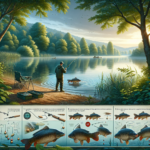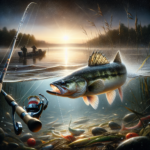Fishing Tips on How to Catch Brook Trout

Introduction
Brook trout, also known as Salvelinus fontinalis, are a beloved species among anglers due to their vibrant colors, spirited fight, and the serene environments they inhabit. These fish are not only a joy to catch but also play a significant role in sport and recreational fishing. This article aims to provide comprehensive tips on how to catch brook trout, covering everything from their physical characteristics and habitats to the best fishing techniques and gear recommendations.
Fish Species Overview
Description
Brook trout are easily recognizable by their striking appearance. They typically have a dark green to brown coloration with a distinctive marbled pattern of lighter shades across their backs and dorsal fins. Their sides are adorned with red spots surrounded by blue halos, and their bellies range from white to a vivid orange, especially during the spawning season. Brook trout generally grow to about 9-10 inches in length, although larger specimens can reach up to 20 inches.
Habitat
Brook trout thrive in cold, clear, and well-oxygenated freshwater environments. They are commonly found in small streams, rivers, and lakes, particularly in the northeastern United States and Canada. These fish prefer habitats with plenty of cover, such as submerged logs, rocks, and overhanging vegetation, which provide protection from predators and strong currents.
Behavior
Brook trout are opportunistic feeders, primarily consuming insects, small fish, and crustaceans. They are most active during dawn and dusk, making these times ideal for fishing. Spawning occurs in the fall, typically from September to November, when water temperatures drop. During this period, brook trout move to shallow, gravelly areas to lay their eggs.
Challenges
Anglers often face several challenges when targeting brook trout. These fish are known for their wariness and can be easily spooked by sudden movements or loud noises. Additionally, their preference for cold, clear waters means that anglers must often venture into remote and rugged terrains to find them.
Best Time to Catch Brook Trout
Seasonal Considerations
The best time to catch brook trout is during the spring and fall. In the spring, the fish are actively feeding after the winter months, making them more likely to bite. Fall is also an excellent time, as brook trout become more aggressive during the spawning season.
Time of Day
Brook trout are most active during the early morning and late evening hours. These times offer lower light conditions, which make the fish feel more secure and willing to venture out to feed. Midday fishing can also be productive, especially in shaded areas or deeper pools.
Weather Conditions
Ideal weather conditions for brook trout fishing include overcast skies and calm waters. Cloudy days reduce light penetration, making the fish less cautious. Additionally, light rain can stimulate feeding activity by washing insects into the water.
Top Fishing Techniques for Brook Trout
Fly Fishing
Fly fishing is one of the most effective techniques for catching brook trout. This method involves using artificial flies that mimic the insects brook trout feed on. Dry flies, nymphs, and streamers are all effective choices. Fly fishing allows for precise presentations and can be particularly effective in small streams and rivers.
Spin Fishing
Spin fishing with ultralight tackle is another popular method for targeting brook trout. Small spinners, spoons, and soft plastic baits can be very effective. The key is to use light gear that allows for delicate presentations, as brook trout can be easily spooked.
Bait Fishing
Bait fishing with natural baits such as worms, minnows, or insects can also yield good results. This technique is especially effective in deeper pools or during periods when the fish are less active. Using a small hook and light line can help increase your chances of success.
Pro Tips
- Stealth: Approach fishing spots quietly and avoid casting shadows over the water.
- Presentation: Ensure your bait or lure mimics the natural movement of the prey.
- Adaptability: Be prepared to switch techniques based on the fish’s behavior and water conditions.
Recommended Gear for Catching Brook Trout
Fishing Rod and Reel
For fly fishing, a 3-5 weight fly rod with a matching reel is ideal. For spin fishing, an ultralight spinning rod and reel combo is recommended. These setups provide the sensitivity and control needed for delicate presentations.
Fishing Line
When fly fishing, use a floating fly line with a tapered leader. For spin fishing, a 2-6 lb test monofilament or fluorocarbon line is suitable. These lines offer the right balance of strength and invisibility in clear waters.
Hooks and Baits
For fly fishing, use size 12-18 dry flies, nymphs, and streamers. For spin fishing, small spinners (size 0-2), spoons, and soft plastics work well. When bait fishing, use size 8-12 hooks with worms, minnows, or insects.
Additional Gear
- Waders: Essential for accessing remote streams and rivers.
- Polarized Sunglasses: Help reduce glare and spot fish in the water.
- Landing Net: A small, rubberized net is ideal for safely landing and releasing fish.
Best Locations to Find Brook Trout
General Locations
Brook trout are typically found in cold, clear freshwater environments. Look for them in small streams, rivers, and lakes with plenty of cover and well-oxygenated water.
Specific Regions
Some of the best regions for brook trout fishing include the northeastern United States (e.g., Maine, New York, Pennsylvania) and Canada (e.g., Quebec, Ontario). These areas offer pristine habitats and abundant brook trout populations.
Common Mistakes to Avoid
Overcasting
One common mistake is casting too far or too often. Brook trout can be easily spooked by excessive casting. Instead, make short, accurate casts and focus on stealthy presentations.
Ignoring Small Streams
Many anglers overlook small streams in favor of larger rivers or lakes. However, small streams often hold healthy populations of brook trout and can provide excellent fishing opportunities.
Using Heavy Gear
Using gear that is too heavy can reduce your chances of success. Brook trout are sensitive to heavy lines and large lures. Opt for ultralight tackle and small baits to increase your chances of a bite.
Catch and Release Tips
Importance of Conservation
Practicing catch and release is crucial for maintaining healthy brook trout populations. This ensures that future generations of anglers can enjoy the thrill of catching these beautiful fish.
Proper Handling Techniques
- Wet Your Hands: Before handling the fish, wet your hands to protect its slime coat.
- Minimize Air Exposure: Keep the fish in the water as much as possible and avoid prolonged air exposure.
- Use Barbless Hooks: Barbless hooks make it easier to release the fish without causing injury.
Legal Considerations
Always check local regulations regarding size limits, bag limits, and protected areas. Adhering to these rules helps preserve brook trout populations and their habitats.
Frequently Asked Questions (FAQs)
What is the best bait for catching brook trout?
The best baits for brook trout include worms, minnows, and insects. Artificial lures such as small spinners, spoons, and flies can also be very effective. The choice of bait often depends on the season and water conditions.
Where is the best place to fish for brook trout?
Brook trout are commonly found in cold, clear freshwater environments such as small streams, rivers, and lakes. Popular regions include the northeastern United States and Canada, where pristine habitats support healthy brook trout populations.
What time of day is best for catching brook trout?
The best times to catch brook trout are during the early morning and late evening hours. These periods offer lower light conditions, making the fish more active and willing to feed.
What type of fishing line should I use for brook trout?
For fly fishing, use a floating fly line with a tapered leader. For spin fishing, a 2-6 lb test monofilament or fluorocarbon line is recommended. These lines provide the right balance of strength and invisibility in clear waters.
Do I need a special fishing license to catch brook trout?
Yes, you typically need a fishing license to catch brook trout. Licensing requirements vary by region, so it’s important to check local regulations. Some areas may also have specific size limits, bag limits, and protected areas.
What is the best technique for catching brook trout?
Fly fishing is often considered the best technique for catching brook trout due to its ability to mimic natural prey. However, spin fishing with ultralight tackle and bait fishing with natural baits can also be very effective.
Are there any specific weather conditions that improve the chances of catching brook trout?
Overcast skies and calm waters are ideal weather conditions for brook trout fishing. Cloudy days reduce light penetration, making the fish less cautious. Light rain can also stimulate feeding activity by washing insects into the water.
Can I catch brook trout from the shore, or do I need a boat?
You can effectively catch brook trout from the shore, especially in small streams and rivers. Wading can also provide access to prime fishing spots. In larger lakes, a boat may be useful for reaching deeper areas.
How can I improve my chances of landing a big brook trout?
To catch larger brook trout, focus on deeper pools and areas with plenty of cover. Use larger baits or lures that mimic the fish’s natural prey. Fishing during the early morning or late evening hours can also increase your chances of landing a big one.
What should I do if I plan to release brook trout after catching them?
When practicing catch and release, handle the fish as little as possible and keep it in the water as much as you can. Use barbless hooks to minimize injury and wet your hands before handling the fish to protect its slime coat. Always follow local regulations regarding size limits and protected areas.
Conclusion
Brook trout fishing offers a rewarding experience for anglers of all skill levels. By understanding their behavior, habitat, and the best techniques for catching them, you can increase your chances of success. Remember to practice ethical fishing practices and conservation to ensure that future generations can enjoy the thrill of catching brook trout. So grab your gear, head to your favorite fishing spot, and put these tips to the test!




